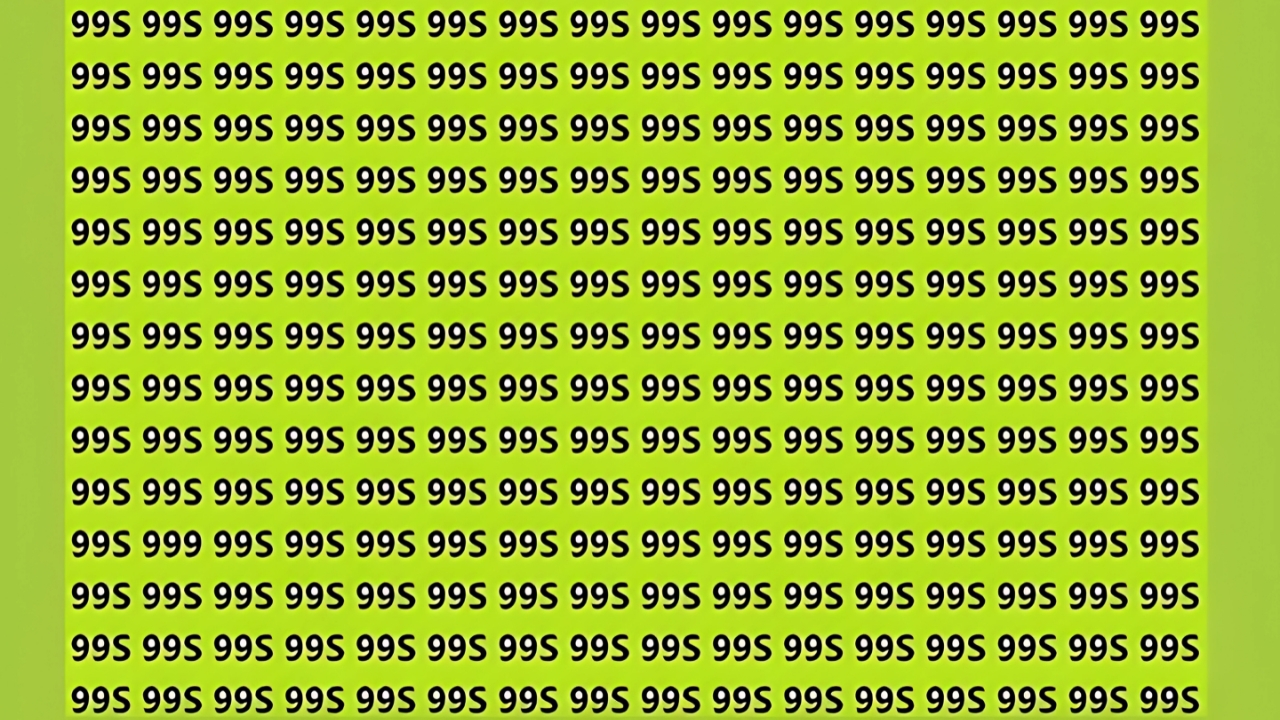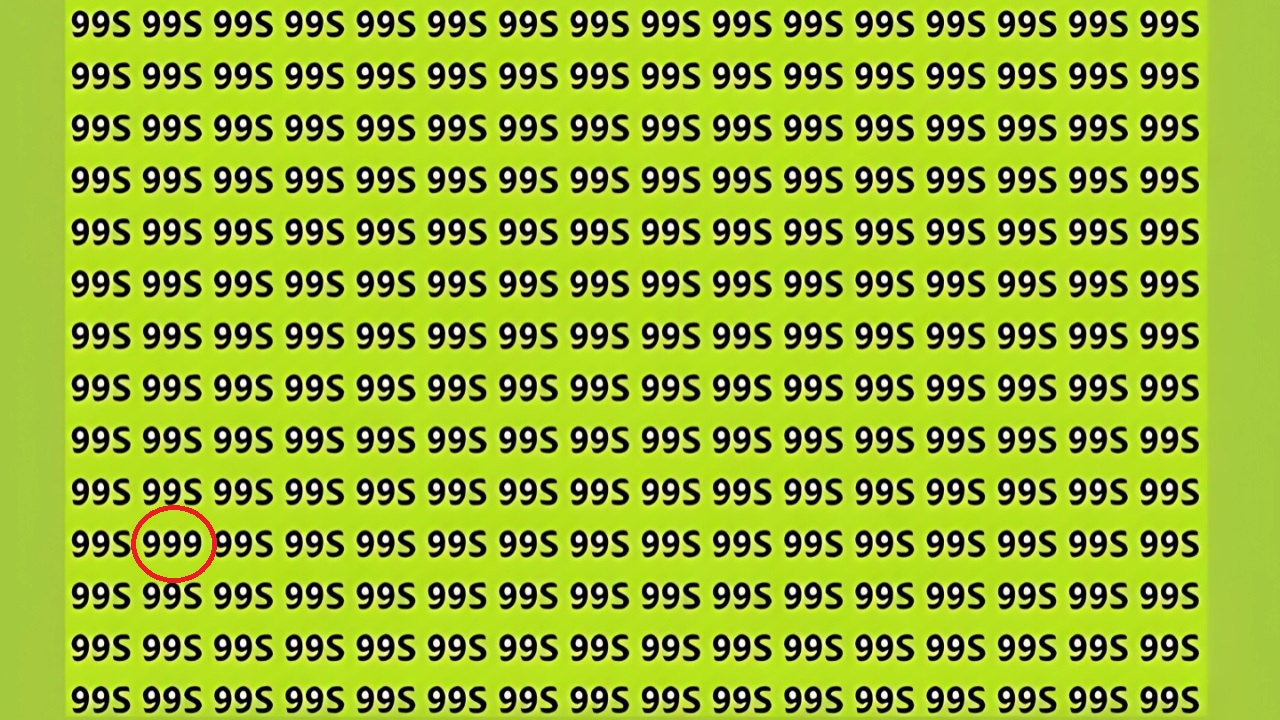999 Optical Illusion Challenges: Have you ever found yourself utterly captivated by an image that seems to shift and transform before your eyes? Welcome to the fascinating world of optical illusions—visual puzzles that play tricks on your mind and test the limits of your perception.
Today, we’re diving into a particularly engaging challenge: spotting the hidden 999 in a complex visual array in just 7 seconds.
The Science Behind Visual Puzzles
Before we reveal the challenge, let’s explore why these visual conundrums captivate our attention so completely. Optical illusions function by exploiting gaps between what our eyes perceive and how our brains interpret that information. When we look at an image, our visual system doesn’t simply record it like a camera—it actively processes, filters, and reconstructs what we see.
Neuroscientists suggest that our brains create mental shortcuts when processing visual information. These shortcuts, while typically helpful for making sense of our complex visual environment, can sometimes lead us astray. This is precisely where optical illusions gain their power—they take advantage of these mental shortcuts, creating a disconnect between reality and perception.
The 7-Second Challenge: More Than Just Fun

Why 7 seconds? This specific timeframe isn’t arbitrary. Studies in cognitive psychology indicate that our ability to quickly identify patterns relates directly to the efficiency of our neural pathways. When we set a time constraint like 7 seconds, we’re essentially testing how quickly our visual processing system can recognize patterns amidst noise.
These timed challenges serve a purpose beyond mere entertainment. They evaluate:
- Visual acuity (the clarity of your vision)
- Pattern recognition abilities
- Processing speed
- Selective attention (focusing on relevant information while ignoring distractions)
Regular engagement with such puzzles may even enhance these cognitive skills over time, much like exercising a muscle.
Today’s Challenge: Finding the Hidden 999
Now, onto our specific challenge: finding the hidden “999” in a sea of numbers.
Imagine a grid filled with hundreds of “666” figures, all arranged in neat rows and columns. Hidden somewhere within this visual chaos is a “999”—identical in shape but inverted. Your task is to locate this unique figure in just 7 seconds.
For many observers, this proves remarkably difficult. The similarity between “6” and “9” creates visual noise that our brains must filter through. Additionally, the pattern repetition establishes a visual expectation, making the aberration harder to spot.
What makes this particular challenge so engaging is the psychological principle known as “change blindness”—our surprising inability to notice changes in our visual field, especially when those changes are subtly integrated into a familiar pattern.
Strategies for Success
If the 7-second limit seems daunting, consider these approaches:
- Systematic scanning: Rather than allowing your eyes to jump randomly across the image, try scanning methodically from top to bottom or left to right.
- Defocusing: Sometimes, paradoxically, slightly unfocusing your eyes helps patterns emerge from visual noise.
- Chunk processing: Mentally divide the image into sections and process each separately.
Look for disruptions: Instead of seeking the “999” directly, look for any break in the pattern of “666” figures.
- Use peripheral vision: Our peripheral vision is particularly adept at detecting motion and pattern anomalies.
Benefits Beyond the Challenge
While these puzzles provide immediate entertainment, their benefits extend far beyond the momentary thrill of discovery. Regular engagement with visual challenges like these can:
- Improve concentration and attention to detail
- Enhance cognitive flexibility
- Reduce cognitive aging effects
- Provide stress relief through focused mental engagement
- Boost visual processing speed
Neuroplasticity research suggests that challenging your brain with novel stimuli—such as complex visual puzzles—promotes the formation of new neural connections. This principle underpins many cognitive training programs designed to maintain mental sharpness throughout aging.
The History of Pattern Recognition Puzzles
These challenges aren’t merely a modern internet phenomenon. Pattern recognition puzzles have ancient roots across numerous cultures. The Chinese tangram, dating back to the Song Dynasty, required arranging seven pieces into specific shapes. Indigenous Australian art often incorporated hidden patterns that told stories within stories.
During World War II, military organizations employed pattern recognition tests to identify individuals with exceptional perceptual abilities for code-breaking and signal intelligence roles. The famous Ishihara color blindness test, developed in 1917, uses similar principles of hidden patterns to assess color perception.
Modern visual puzzles like our “999” challenge represent the evolution of this long tradition, now optimized for viral sharing and quick engagement in our digital age.
The Psychology of “Aha!” Moments
When you finally spot the hidden “999,” you’ll likely experience what psychologists call an “Aha!” or “Eureka” moment—that sudden jolt of satisfaction when the solution becomes clear. This experience triggers a dopamine release in the brain, creating a natural reward that keeps us coming back for more puzzles.
Interestingly, this same neural mechanism underlies many addictive behaviors, which explains why many people find these visual challenges so engrossing. The brief struggle followed by the pleasure of discovery creates a compelling psychological loop.
Creating Your Own Visual Challenges
Inspired to create your own visual puzzles? Consider these principles:
- Establish a strong pattern with a subtle deviation
- Leverage similarities between different symbols (like 6 and 9, or B and 8)
- Introduce distractors that draw attention away from the solution
- Consider using color, orientation, or size as the distinguishing factor
- Test your creation on friends to calibrate difficulty
Digital tools like Photoshop or even simpler graphics programs offer various filters and effects that can help create compelling visual illusions with hidden elements.
Beyond Numbers: The World of Optical Illusions
While our focus today has been on finding the hidden “999,” the world of optical illusions extends far beyond simple number patterns. Consider exploring:
- Ambiguous illusions: Images with multiple valid interpretations (like the famous duck-rabbit illusion)
- Motion illusions: Static images that appear to move or pulse
- Geometric illusions: Where straight lines appear curved or parallel lines seem to converge
- Color constancy illusions: Demonstrating how our perception of color depends on context
- Size illusions: Where identical objects appear different sizes based on their surroundings
Each type challenges different aspects of our visual processing system and reveals unique insights about how we construct our perception of reality.
Visual Processing Across the Lifespan
Our ability to tackle visual challenges like finding the hidden “999” changes throughout our lives. Young children often struggle with these puzzles due to still-developing visual processing systems. During adolescence, pattern recognition abilities typically peak, making teenagers surprisingly adept at these challenges.
As we age, our visual processing generally slows, but experience and wisdom often compensate with more strategic approaches. Remarkably, regular engagement with visual puzzles may help maintain cognitive flexibility well into older age—another compelling reason to enjoy these challenges regardless of your life stage.
Cultural Variations in Visual Processing
Fascinatingly, cultural background influences how we perceive and solve visual puzzles. Research suggests that people from cultures with non-alphabetic writing systems (like Chinese characters) often process visual information differently than those from cultures using alphabetic systems.
These differences extend to how quickly someone might spot our hidden “999.” Some cultures emphasize holistic visual processing (seeing the entire image as a unified whole), while others favor analytic processing (focusing on individual elements). Neither approach is superior, but they may lead to different success rates with various types of visual challenges.
When Optical Illusions Reveal Medical Conditions
Beyond entertainment, similar visual tests sometimes serve diagnostic purposes. Certain medical conditions affect pattern recognition abilities in specific ways. For instance, individuals with conditions affecting the visual cortex may struggle with particular types of visual puzzles while excelling at others.
Some neurological conditions can actually enhance pattern recognition—many individuals with autism spectrum conditions demonstrate exceptional abilities to identify details within complex visual scenes, potentially spotting our hidden “999” much faster than the average observer.
The Solution Revealed

If you’ve been searching for the hidden “999” throughout this article, you might be feeling a bit puzzled—and rightfully so! The described challenge is a concept rather than an actual image presented here. In a real version of this challenge, you would see an image filled with “666” figures with one “999” hidden among them.
These types of visual puzzles typically appear as actual images on social media, brain teaser websites, or in puzzle books, where you can test your perceptual skills against the clock. The principle remains the same: finding the anomaly within a sea of similarities under time pressure.
Why We Love the Challenge
Our fascination with challenges like “Spot the 999 in 7 seconds” speaks to something fundamental about human cognition. We are natural pattern seekers, constantly scanning our environment for regularities and anomalies. This ability served our ancestors well for detecting both opportunities (like food sources) and threats (like camouflaged predators).
In our modern world, where survival rarely depends on spotting the hidden leopard in the undergrowth, these visual puzzles satisfy that same ancient neural circuitry. They provide a safe, engaging way to exercise our perceptual abilities while delivering the satisfaction of discovery.
So next time you encounter one of these challenges, remember: you’re not just entertaining yourself—you’re engaging in an activity that connects you to both our evolutionary past and the cutting edge of cognitive science. And whether you spot the hidden “999” in 7 seconds or 70, the real value lies in the mental journey along the way.
